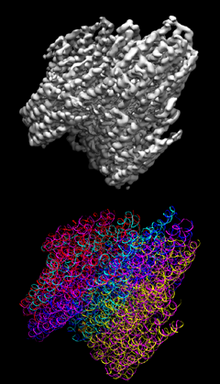
DNA origami (wikipedia).
Today Prof. Tim Liedl from the LMU in Germany presented his research about "DNA origami" which is indeed about looking at DNA parts as LEGO blocks and connecting them in a way that you can build a lot of different structures. It was especially exciting to see that it's possible to program shapes (e.g. a smiley) and the DNA assembles into exactly this shape and not into some random configuration. To achieve this, short DNA strings are coded so that the only have one partner for a certain sight.
That's one of the points why DNA is so cool and often used in labs. It's not only easy to handle and to buy, it can be programmed which can become to the structure shown in the image above. Here, the biological function is not interesting at all, but still it's the stuff we are made of and it's got a huge amount of interesting properties.